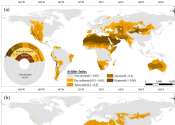The Satellite Data System (SDS) is a system of United States military communications satellites. At least three generations have been used: SDS-1 from 1976 to 1987; SDS-2 from 1989 to 1996; SDS-3 from 1998 to the present. SDS satellites have a highly elliptical orbit, going from about 300 kilometers at perigee to roughly 39,000 km at apogee in order to allow communications with polar stations that cannot contact geosynchronous satellites. The high apogee meant that the polar regions were visible for long amounts of time, and only two satellites were required in order to achieve constant communications ability. The SDS satellites were constructed by Hughes Aircraft.
The primary purpose of the SDS satellites is to relay imagery from low-flying reconnaissance satellites to ground stations in the United States.
Each SDS-1 satellite had 12 channels available for ultra-high frequency communication. They were cylindrical in shape, roughly 25 feet (7.6 m) long. 980 watts of electrical power were available from solar panels and batteries. The SDS-1 had a mass of 1385 pounds (630 kilograms) and was launched on Titan-3B rockets. The SDS-1 satellites had similar orbits to the Air Force's Jumpseat ELINT satellites.
The SDS-2 is significantly more massive at 5150 pounds (2335 kg), with three separate communication dishes, including one for a K band downlink. Two dishes are 15 feet (4.5 meters) in diameter, while the third is 6.6 feet (2 m) in diameter. The solar arrays generate 1238 watts of power. It is believed that the Space Shuttle has been used to launch several satellites, possibly on missions STS-28, STS-38, and STS-53. Other launches have used the Titan-4 rocket.
Quasar is the rumored code name for the communications satellite.
A recent Quasar may have been launched into a high-apogee orbit from Cape Canaveral on August 31, 2004 by an Atlas 2AS rocket.









